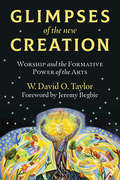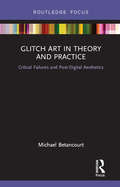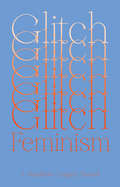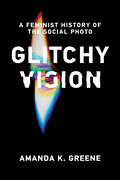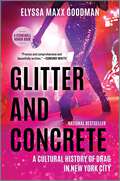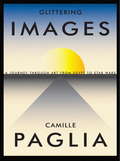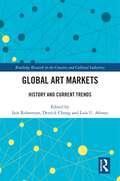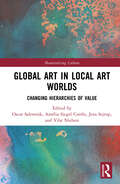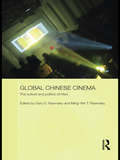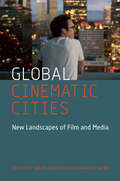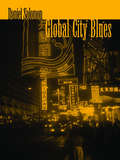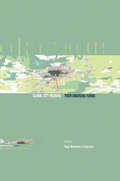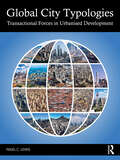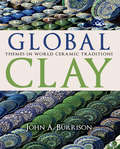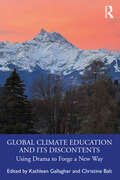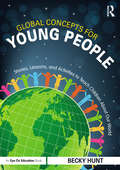- Table View
- List View
Glimpses of the New Creation: Worship and the Formative Power of the Arts
by Jeremy Begbie W. David TaylorHow do the arts in worship form individuals and communities?Every choice of art in worship opens up and closes down possibilities for the formation of our humanity. Every practice of music, every decision about language, every use of our bodies, every approach to visual media or church buildings forms our desires, shapes our imaginations, habituates our emotional instincts, and reconfigures our identity as Christians in contextually meaningful ways, generating thereby a sense of the triune God and of our place in the world.Glimpses of the New Creation argues that the arts form us in worship by bringing us into intentional and intensive participation in the aesthetic aspect of our humanity—that is, our physical, emotional, imaginative, and metaphorical capacities. In so doing they invite the people of God to be conformed to Christ and to participate in the praise of Christ and in the praise of creation, which by the Spirit’s power raises its peculiar voice to the Father in heaven, for the sake of the world that God so loves.
Glitch Art in Theory and Practice: Critical Failures and Post-Digital Aesthetics
by Michael BetancourtGlitch Art in Theory and Practice: Critical Failures and Post-Digital Aesthetics explores the concept of "glitch" alongside contemporary digital political economy to develop a general theory of critical media using glitch as a case study and model, focusing specifically on examples of digital art and aesthetics. While prior literature on glitch practice in visual arts has been divided between historical discussions and social-political analyses, this work provides a rigorous, contemporary theoretical foundation and framework.
Glitch Feminism: A Manifesto
by Legacy RussellA new manifesto for cyberfeminismThe divide between the digital and the real world no longer exists: we are connected all the time. How do we find out who we are within this digital era? Where do we create the space to explore our identity? How can we come together and create solidarity? The glitch is often dismissed as an error, a faulty overlaying, but, as Legacy Russell shows, liberation can be found within the fissures between gender, technology and the body that it creates. The glitch offers the opportunity for us to perform and transform ourselves in an infinite variety of identities. In Glitch Feminism, Russell makes a series of radical demands through memoir, art and critical theory, and the work of contemporary artists who have travelled through the glitch in their work. Timely and provocative, Glitch Feminism shows how the error can be a revolution.
Glitchy Vision: A Feminist History of the Social Photo
by Amanda K. GreeneA novel exploration of popular photographic media cultures in 1930s Europe through a feminist lens—and how visual social media changes what it means to be human both then and now.Glitchy Vision takes a feminist approach to media history to examine how photographic social media cultures change human bodies and the experience of being human. To illuminate these glitches, Greene focuses on the inevitable distortions that arise from looking at the past through the lens of the present. Treating these distortions as tools as opposed to obstacles, Greene uncovers new ways of viewing social media cultures of the past, while also revealing parallels between historical contexts and our contemporary digital media environment.Greene uses three &“born-digital keywords&”—real time, algorithmic filters, and sousveillance—to examine photographic media environments in and around 1930s Europe. Each chapter of the book places one of the keywords in dialogue with an unconventional archive of popular &“feminized&” cultural artifacts and technological innovations from this historical moment that have been overlooked as critical resources for media studies: Evelyn Waugh&’s bestselling novel Vile Bodies (1930) and photographic reproductions for the tabloid press; Lee Miller&’s war photography for British Vogue and glamourous photo-retouching techniques; and the Mass-Observation Movement&’s surrealist anthropology.Glitchy Vision provides new strategies for reading history that show how small shifts in the circuits that connect bodies and media affect what it means to be human both in the past and today.
Glitter Every Day: 365 Quotes from Women I Love
by Andy CohenThe Instant New York Times BestsellerFrom Andy Cohen, the New York Times bestselling author and host of Watch What Happens Live comes an inspiring collection of daily quotes from the larger-than-life women that defined his life, offering inspiration, affirmation, and (just enough) intoxication to make any day shine bright – the perfect gift for the holidays! Andy Cohen has made a career, and a life, out of making the ordinary extraordinary. The inspiration for this fabulous view of the world has always come from the incredible women (from his mother to Madonna) he loves. In Glitter Every Day Andy shares his most needed words of wisdom from his favorite icons for every day, just in time to kick off the new year!Andy not only gathers 365 sayings and quotes from the icons, thought leaders, Real Housewives and legendary celebs that fuel his fun, he writes about the people and experiences that have made him live one of the most joyous lives that any little boy growing up in St. Louis could dream of so that you can, too. And like Andy himself, Glitter Every Day is irresistible, infusing your day with a laugh, a pep talk and a shot(ski) of fun.So pour a drink, put on your heels, and always remember to let yourself shine.
Glitter Everywhere!: Where it Came From, Where It's Found & Where It's Going
by Chris BartonFans of How It&’s Made will love this fresh, irreverent look at the science and story behind glitter.If you love glitter, this book is for you. If you hate glitter, this book is also for you.Everyone seems to have an opinion about glitter. But how much do you know about the tiny, shiny confetti? What makes glitter glitter? Why does it stick to everything? Who invented it? How is it made? Is glitter bad for the environment?Chris Barton&’s informative wit and Chaaya Prabhat's vibrant art make Glitter Everywhere sparkle as it covers the good, the bad, and shiny of all things glitter.
Glitter and Concrete: A Cultural History of Drag in New York City
by Elyssa Maxx Goodman*NATIONAL BESTSELLER**A STONEWALL AWARD HONOR BOOK**The Millions Most Anticipated List of 2023**A Vogue Best LGBTQ+ Book of 2023*From journalist and drag historian Elyssa Maxx Goodman, an intimate, evocative history of drag in New York City exploring its dynamic role, from the Jazz Age to Drag Race, in queer liberation and urban lifeFrom the lush feather boas that adorned early female impersonators to the sequined lip syncs of barroom queens to the drag kings that have us laughing in stitches, drag has played a vital role in the creative life of New York City. But the evolution of drag in the city—as an art form, a community and a mode of liberation—has never before been fully chronicled.Now, for the first time, Elyssa Goodman unearths the dramatic, provocative untold story of drag in New York City in all its glistening glory. Glitter and Concrete ducks beneath the velvet ropes of Harlem Renaissance balls, examines drag&’s crucial role in the Stonewall Uprising, traces drag's influence on disco and punk rock as well as its unifying power during the AIDS crisis and 9/11, and culminates with the modern-day drag queen in the era of RuPaul&’s Drag Race.Including original interviews with high-profile performers, as well as glamorous color photos from exclusive sources and the author herself, Glitter and Concrete is a significant contribution to queer history and an essential read for anyone curious about the story that echoes beneath the heels."Deeply researched and featuring a cast of characters who can truly be described as fabulous, Glitter and Concrete is urban history on fire." —Thomas Dyja, author of New York, New York, New York
Glittering Images
by Camille PagliaFrom the best-selling author of Sexual Personae and Break, Blow, Burn and one of our most acclaimed cultural critics, here is an enthralling journey through Western art's defining moments, from the ancient Egyptian tomb of Queen Nefertari to George Lucas's volcano planet duel in Revenge of the Sith.America's premier intellectual provocateur returns to the subject that brought her fame, the great themes of Western art. Passionately argued, brilliantly written, and filled with Paglia's trademark audacity, Glittering Images takes us on a tour through more than two dozen seminal images, some famous and some obscure or unknown--paintings, sculptures, architectural styles, performance pieces, and digital art that have defined and transformed our visual world. She combines close analysis with background information that situates each artist and image within its historical context--from the stone idols of the Cyclades to an elegant French rococo interior to Jackson Pollock's abstract Green Silver to Renée Cox's daring performance piece Chillin' with Liberty. And in a stunning conclusion, she declares that the avant-garde tradition is dead and that digital pioneer George Lucas is the world's greatest living artist. Written with energy, erudition, and wit, Glittering Images is destined to change the way we think about our high-tech visual environment.
Global Art Markets: History and Current Trends (Routledge Research in the Creative and Cultural Industries)
by Derrick Chong Iain Robertson Luís U. AfonsoThe art market is worth billions globally, despite the effects of the Covid-19 health pandemic. This book brings together a strong cast of contributors to explore contemporary and historical themes.Readers of the book will gain awareness of how historical foundations of arts markets continue to impact on contemporary global developments, while transformational digital technology shakes up the art world. With new insights into emerging arts markets, the book also covers themes and phenomena such as NFTs, secrecy, platforms, and financialization in the arts.The result is a book that will prove valuable reading for scholars involved in art markets studies.
Global Art in Local Art Worlds: Changing Hierarchies of Value (Materializing Culture)
by Oscar Salemink Amélia Siegel Corrêa Jens Sejrup Vibe NielsenThis book explores the attribution and local negotiation of cultural valuations of artistic and art-institutional practices around the world, and considers the diverse ways in which these value attributions intersect with claims of universality and cosmopolitanism. Taking Michael Herzfeld’s notion of the “global hierarchy of value” as point of departure, the volume brings together six empirical studies of the collection, circulation, classification and exhibition of objects in present-day Brazil, China, India, Japan, South Africa and Indigenous Australia in light of Europe’s loss of global hegemony. Including reflections by a number of senior scholars, the chapters demonstrate that the question of valuation lies at the heart of artistic and art-institutional practices writ large – including museum practices, museum architecture, galleries, auction houses, art fairs and biennales.
Global Bollywood
by Anandam P. Kavoori Aswin PunathambekarBollywood is one of the most prolific film industries in the world. Based in Mumbai (formerly Bombay), the industry churns out hundreds of films each year--primarily melodramatic films with music and elaborately choreographed dance routines. Bollywood's popularity is quickly spreading across the globe, and, beyond the films themselves, Bollywood has made its way into global popular culture. Global Bollywood brings together leading scholars to examine the transnational and transmedia terrain of Bollywood. Defining Bollywood as an arena of public culture distinct from Hindi-language Bombay cinema, this volume offers a new critical framework for analyzing the institutional, cultural, and political dimensions of Bollywood films and film music as they begin to constitute an important circuit of global flows in the twenty-first century. Organized thematically, the book examines contestations surrounding the term "Bollywood," changing relations between the state and the film industry, convergence with television and new media, online fan culture, film journalism, and the reception and negotiations of gender and sexuality in diverse socio-cultural contexts. Global Bollywood is indispensable for understanding not only Bollywood cinema and culture but also how global media flows are reconfiguring relationships among geography, cultural production, and cultural identity.
Global Bollywood: Travels of Hindi Song and Dance
by Sangita Gopal Sujata MoortiBollywood movies and their signature song-and-dance spectacles are an aesthetic familiar to people around the world, and Bollywood music now provides the rhythm for ads marketing goods such as computers and a beat for remixes and underground bands. These musical numbers have inspired scenes in Western films such as Vanity Fair and Moulin Rouge.Global Bollywood shows how this currency in popular culture and among diasporic communities marks only the latest phase of the genre&’s world travels. This interdisciplinary collection describes the many roots and routes of the Bollywood song-and-dance spectacle. Examining the reception of Bollywood music in places as diverse as Indonesia and Israel, the essays offer a stimulating redefinition of globalization, highlighting the cultural influence of Hindi film music from its origins early in the twentieth century to today.Contributors: Walter Armbrust, Oxford U; Anustup Basu, U of Illinois, Urbana-Champaign; Nilanjana Bhattacharjya, Colorado College; Edward K. Chan, Kennesaw State U; Bettina David, Hamburg U; Rajinder Dudrah, U of Manchester; Shanti Kumar, U of Texas, Austin; Monika Mehta, Binghamton U; Anna Morcom, Royal Holloway College; Ronie Parciack, Tel Aviv U; Biswarup Sen, U of Oregon; Sangita Shrestova; Richard Zumkhawala-Cook, Shippensburg U.Sangita Gopal is assistant professor of English at the University of Oregon. Sujata Moorti is professor of women&’s and gender studies at Middlebury College.
Global Broadcasting Systems (Routledge Library Editions: Broadcasting #21)
by Michael C. Keith Robert L. HilliardGlobal Broadcasting Systems (1996) provides a comprehensive look at broadcasting throughout the world. It covers every continent, region and almost every country in North and South America, Europe, Africa, Asia and Oceania. Within each geographical area, it presents the history, key issues, trends and status of broadcasting facilities and penetration; the control, regulation and management of networks and stations by government, domestic and foreign industry and the public; the financing of broadcasting systems; programming types and trends, including foreign imports; media freedom and censorship; and external radio and television services from other countries. The book discusses how new technology and political, social and economic factors influence the global media, and shows how increasing privatization has changed patterns of control and access.
Global Chinese Cinema: The Culture and Politics of 'Hero' (Media, Culture and Social Change in Asia)
by Gary D. RawnsleyThe film Hero, directed by Zhang Yimou and released in 2002, is widely regarded as the first globally successful indigenous Chinese blockbuster. A big expensive film with multiple stars, spectacular scenery, and astonishing action sequences, it touched on key questions of Chinese culture, nation and politics, and was both a domestic sensation and an international hit. This book explores the reasons for the film’s popularity with its audiences, discussing the factors which so resonated with those who watched the film. It examines questions such as Chinese national unity, the search for cultural identity and role models from China’s illustrious pre-communist past, and the portrayal of political and aesthetic values, and attitudes to gender, sex, love, and violence which are relatively new to China. The book demonstrates how the film, and China’s growing film industry more generally, have in fact very strong international connections, with Western as well as Chinese financing, stars recruited from the East Asian region more widely, and extensive interactions between Hollywood and Asian artists and technicians. Overall, the book provides fascinating insights into recent developments in Chinese society, popular culture and cultural production.
Global Cinematic Cities: New Landscapes of Film and Media
by Lawrence Webb Andersson JohanCinema and audiovisual media are integral to the culture, economy and social experience of the contemporary global city. But how has the relationship between cinema and the urban environment evolved in the era of digital technology, new media and globalization? And what are the critical tools and concepts with which we can grasp this vital interconnection between space and screen, viewer and built environment? Engaging with a rapidly transforming urban world, the contributions to this collection rethink the 'cinematic city' at a global scale. By presenting a global constellation of screen cities within one volume, the book encourages juxtapositions and comparisons across the North and South to capture the global city and its dynamics of exchange, hybridity, and circulation. The contributions examine film and screen cultures in a range of locations spanning five continents: Antibes, Beijing, Buenos Aires, Busan, Cairo, Caracas, Copenhagen, Jakarta, Kolkata, Lagos, Los Angeles, Malmö, Manila, Mumbai, Nairobi, Paris, Seoul, Sète, and Shanghai. The chapters address topics that range across the contemporary film and media landscape, from popular cinema, art cinema, and film festivals to serial television, public screens, multimedia installations, and video art. Contributors: Chris Berry, Yomi Braester, Jinhee Choi, Pei-Sze Chow, Thomas Elsaesser, Malini Guha, Jonathan Haynes, Will Higbee, Igor Krstic, Christian B. Long, Joanna Page, Lawrence Webb.
Global Cinematic Cities: New Landscapes of Film and Media
by Johan Andersson Lawrence WebbCapturing a rapidly transforming urban world, this collection investigates the emerging dynamics between filmmaking and urban change on a global scale. It surveys film, media and screen cultures in Buenos Aires, Beijing, Berlin, Cairo, Copenhagen, Delhi, Kolkata, Lagos, Los Angeles, Malmö, Manila, Paris, Rome, and Shanghai. Drawing on work in film and urban studies, the volume innovatively rethinks the "cinematic city" and argues for its ongoing relevance. Film festivals, transnational production, public screens, media ecologies, nostalgia, cinephilia, infrastructure, and informal economies illuminate the juxtaposition of cinema and urban space. Works covered include The Bourne Legacy (2012), Her (2013), Medianeras (2011), Last Flight to Abuja (2012), Maach, Mishti, and More (2013), The Future of the Past (2012), Good Morning Aman (2009), Couscous (2007), the transnational television production The Bridge, and Chinese video art.
Global Citizenship, Ecomedia and English Language Education (Palgrave Studies in Education and the Environment)
by Ricardo RömhildThis book presents a unique framework for the inclusion of ecomedia in the English language classroom to help learners cultivate global citizenship. Foregrounding learner agency in a world at risk, the author proposes a framework that hinges on human rights and critical eco-cosmopolitanism to help learners position themselves in discourses on climate change and act for transformation. The book discusses eco-documentaries as multimodal, factional texts against the background of cutting-edge research, refuting a definition based on the binary of fiction and non-fiction. Translating the insights gained from this discussion to the language education context, learners are conceptualised as active designers of meaning making when engaged with eco-documentaries. Based on this discussion, the book puts forth an innovative, multiliteracies-informed concept which is embedded in a sustainability-oriented pedagogy of hope, which encourages learners to learn and practice languages of hope and advocacy. The book will be of interest to scholars in the fields of ecopedagogy, sustainability education, global citizenship education and cultural learning, film pedagogy and language education, as well as language educators.
Global City Blues
by Daniel Solomon"This is a book about the making of cities and the buildings that compose them. It is about the conditions under which an architect engaged in those activities now works, how those conditions evolved and why they are changing. It is about the qualities of life that are threatened by the ways cities are built at the beginning of the 21st century and intelligent response to those threats. It is about why the city planning ideas and the cultural cuisinart that came in the box with modern architecture are a lingering menace." -- from Global City Blue.In Global City Blues, renowned architect Daniel Solomon presents a perceptive overview and an insightful assessment of how the power and seductiveness of modernist ideals led us astray. Through a series of independent but linked essays, he takes the reader on a personal picaresque, introducing us to people, places, and ideas that have shaped thinking about planning and building and that laid the foundation for his beliefs about the world we live in and the kind of world we should be making.As an alternative, Daniel Solomon discusses the ideas and precepts of New Urbanism, a reform movement he helped found that has risen to prominence in the past decade. New Urbanism offers a vital counterbalance to the forces of sprawl, urban disintegration, and placelessness that have so transformed the contemporary landscape.Global City Blues is a fresh and original look at what the history of urban form can teach us about creating built environments that work for people.
Global City Regions: Their Emerging Forms
by Roger Simmonds Gary HackA unique comparative study based on funded research, of eleven city regions across three continents looking at changes over the last 30 years. Detailed changes in land use are presented here with series of maps prepared especially for the study. The socio-economic and physical forms of city regions have been examined for comparative study and the findings will be of interest to all those concerned with urban development in their professional and academic work. The book features numerous maps which underline research findings. Cities covered are: Ankara, Bangkok, Boston, Madrid, Randstad, San Diego, Chile, Sao Paulo, Seattle and the Central Puget, Taipei, Tokyo, West Midlands.
Global City Typologies: Transactional Forces in Urbanised Development
by Nigel C. LewisGlobal City Typologies explores the historical, cultural and socio-economic transactional forces in the development of existing cities through to newly planned and emerging cities. Individual chapters address different sets and typologies of global cities to analyse their comparative evolution and standing today. The separate parts and individual chapters have been grouped around 125 different established, planned and emerging cities and analysed according to different typologies and thematic categories that comprise historic cities, early trading cities, planned cities, emerging global cities, mega cities and megalopolitan agglomerations. These span five continents – including the industrial cities of Chicago and Manchester, new capitals such as Brasília and New Delhi, innovative cities such as Singapore and Tel Aviv and mega cities such as Mexico City. The book is fully illustrated throughout with modern and historical maps, which enables visualisation of the forces that have shaped ongoing development of these major global cities. This is an essential book for students and professionals in urban design and planning, administrators, economists, designers and developers.
Global Clay: Themes in World Ceramic Traditions
by John A. BurrisonFor over 25,000 years, humans across the globe have shaped, decorated, and fired clay. Despite great differences in location and time, universal themes appear in the world’s ceramic traditions, including religious influences, human and animal representations, and mortuary pottery. In Global Clay: Themes in World Ceramic Traditions, noted pottery scholar John A. Burrison explores the recurring artistic themes that tie humanity together, explaining how and why those themes appear again and again in worldwide ceramic traditions. The book is richly illustrated with over 200 full-color, cross-cultural illustrations of ceramics from prehistory to the present. Providing an introduction to different styles of folk pottery, extensive suggestions for further reading, and reflections on the future of traditional pottery around the world, Global Clay is sure to become a classic for all who love art and pottery and all who are intrigued by the human commonalities revealed through art.
Global Clay: Themes in World Ceramic Traditions
by John A. BurrisonFor over 25,000 years, humans across the globe have shaped, decorated, and fired clay. Despite great differences in location and time, universal themes appear in the world's ceramic traditions, including religious influences, human and animal representations, and mortuary pottery. In Global Clay: Themes in World Ceramic Traditions, noted pottery scholar John A. Burrison explores the recurring artistic themes that tie humanity together, explaining how and why those themes appear again and again in worldwide ceramic traditions. The book is richly illustrated with over 200 full-color, cross-cultural illustrations of ceramics from prehistory to the present. Providing an introduction to different styles of folk pottery, extensive suggestions for further reading, and reflections on the future of traditional pottery around the world, Global Clay is sure to become a classic for all who love art and pottery and all who are intrigued by the human commonalities revealed through art.
Global Climate Education and Its Discontents: Using Drama to Forge a New Way
by Kathleen Gallagher Christine BaltThis innovative and practical book offers pedagogical tools to show how drama can be used in educational settings to advance a relational, action-oriented, interdisciplinary, and creative climate education attuned to the social and emotional effects of the climate emergency. Based on a six-year ethnographic research study taking place with teachers, artists, community leaders, and young people globally, and taking its lead from the following provocation – can performance become a site for new imaginaries for socio-ecological justice? – the book explores the unique conceptual and pedagogical ‘discontents’ of climate education across geographically and culturally distinct sites of learning. It also examines how artful engagement through drama pedagogies can open up more collective, critical, and hopeful forms of thinking and being.The book is divided into two sections. The first part of the book, Local engagements and encounters, consists of chapters that conduct an in-depth appraisal of the local artistic work from each site, examining how matters of socio-ecological justice are given fresh urgency and complexity through the application of performance as pedagogy. The second part of the book, Pedagogical and artistic innovations, offers substantive praxis chapters on the drama-based pedagogical methods employed in the research. In these chapters, the world-building capacities of theatre-making offer up new, performative pedagogical orientations to the climate emergency beyond those of critique.Global Climate Education and Its Discontents: Using Drama to Forge a New Way is valuable reading for scholars interested in the ontological and epistemological dimensions of the climate emergency, especially within and across the following fields: drama, theatre and performance studies, applied theatre and drama education, educational research, and children/childhood and youth studies. The book also invites a readership of teachers and teacher-educators who are interested in applying drama pedagogies in the classroom to explore matters of socio-ecological justice and the climate crisis.
Global Concepts for Young People: Stories, Lessons, and Activities to Teach Children About Our World
by Becky HuntLearn how to teach global concepts and use them to increase critical thinking across the curriculum. In this new book from popular consultant Becky Hunt, you’ll get ready-to-use lesson plans, stories, and activities to help you teach five key global concepts—Change, Interdependence, Culture, Scarcity, and Power. Aligned with both the C3 Social Studies Framework and the Common Core State Standards for English Language Arts, these engaging lesson plans encourage critical thinking skills that will lead to increased creativity in problem solving. This book is an essential resource for teachers looking to: Create a framework to teach young people global concepts that will help them analyze and understand the world. Present stories and lessons connected to real-world issues that inspire students to develop innovative solutions. Engage students in lessons that will help them to understand and celebrate people from different cultures at home and around the world. Shape students into global citizens with an understanding of the world and a desire to bring about change. Special features include anchor stories, games, graphic organizers, and critical-thinking questions. Many of the tools are available as eResources on our website, www.routledge.com/9781138237940, so you can print and use them in your classroom immediately.
Global Construction Data
by Stephen GrunebergGlobal construction data is vital for contractors, governments, international organisations, policy makers, academic researchers and statisticians. As the global population of the world expands, the sustainability of the built environment raises the political agenda and the need to manage infrastructure and buildings in both urban and rural contexts becomes ever more pressing. How much more can the built environment grow and how can it be managed sustainably? This edited volume addresses how we can find a possible way through the inconsistencies between national construction data sets to devise a consistent approach to national construction data to further the global sustainability agenda and inform policy making. This search begins in Part I, which looks at the methods and definitions used in construction statistics in different countries. Part II considers examples of different types of construction data from the cost of materials, measuring work on high rise buildings and existing stock. In Part III, the authors consider construction data internationally, beginning with the problem of comparing data in different countries using exchange rates and purchasing power parities (PPPs), comparing innovation processes in different countries and looking at the provision of building design internationally. In Part IV, the international theme is continued by comparing accounting practices and company performance in different countries and concludes with an international comparison of construction industries. This book raises awareness of the significance of the construction industry globally and the importance of data to measure it. It informs the discussion of the best ways of handling the consequences of policies affecting the built environment and the effect of the built environment on the rest of the economy and society. It is essential reading for international economists, construction industry consultants, policy makers, construction statisticians and academics.
